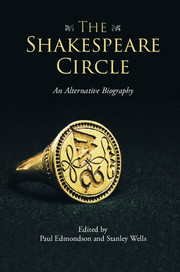Book contents
- Frontmatter
- Contents
- List of illustrations
- List of contributors
- Preface and acknowledgements
- General introduction
- Part I Family
- 1 His Mother Mary Shakespeare
- 2 His father John Shakespeare
- 3 His siblings
- 4 His sister's family: the Harts
- 5 His wife Anne Shakespeare and the Hathaways
- 6 His daughter Susanna Hall
- 7 His son-in-law John Hall
- 8 His son Hamnet Shakespeare
- 9 His daughter Judith and the Quineys
- 10 His granddaughter Lady Elizabeth Barnard
- 11 His ‘cousin’: Thomas Greene
- Part II Friends and Neighbours
- Part III Colleagues and Patrons
- Closing remarks
- Afterword
- Index
- References
11 - His ‘cousin’: Thomas Greene
from Part I - Family
Published online by Cambridge University Press: 05 November 2015
- Frontmatter
- Contents
- List of illustrations
- List of contributors
- Preface and acknowledgements
- General introduction
- Part I Family
- 1 His Mother Mary Shakespeare
- 2 His father John Shakespeare
- 3 His siblings
- 4 His sister's family: the Harts
- 5 His wife Anne Shakespeare and the Hathaways
- 6 His daughter Susanna Hall
- 7 His son-in-law John Hall
- 8 His son Hamnet Shakespeare
- 9 His daughter Judith and the Quineys
- 10 His granddaughter Lady Elizabeth Barnard
- 11 His ‘cousin’: Thomas Greene
- Part II Friends and Neighbours
- Part III Colleagues and Patrons
- Closing remarks
- Afterword
- Index
- References
Summary
Thomas Greene's claim to be considered an intimate member of the Shakespeare circle rests on two pieces of evidence, both in his own hand. The first is an explicit claim to kinship; in notes kept between November 1614 and January 1615 relating to the enclosure of land at Welcombe, Greene refers three times to William Shakespeare as his ‘cousin’ and details some exchanges between them (SBT BRU 15/13/27–29). The second claim rests on a passing and indirect reference to a practical relationship; in correspondence dated 9 September 1609 about the activities of a tenant in his house called St Mary's, Greene mentions he is in no hurry to take possession ‘because I perceived I might stay another year at New Place’ (BRU 15/12/103). This brief and enigmatic comment suggests that Greene shared accommodation with Shakespeare, presumably as a paying lodger, at his town house in Stratford-upon-Avon. How long Greene lived there is not known but this tantalising glimpse into his domestic arrangements indicates not only physical proximity to the Shakespeare family but also, potentially, an active interest in their household affairs. What might it have meant to Shakespeare to have a self-styled ‘cousin’ at the margins of kinship occupy the physical and metaphorical body of the household, the fundamental unit of early modern society and an environment through which wider circles of influence operated?
Thomas Greene cannot claim an entry in the Oxford Dictionary of National Biography but the details of his life and career are provided by Robert Bearman, who points out that ‘more evidence exists to document Shakespeare's dealings with Greene than with any other of his contemporaries’ (Bearman 2012, p. 304). Bearman describes his subject as a ‘representative of a minor town gentry family, who for fifteen years was town clerk, or steward, of Stratford-upon-Avon’. After training in law it appears Greene worked on an ad hoc basis for the Corporation before being appointed town steward in August 1603. He married Lettice, daughter of Henry Tutt, a gentleman of Hampshire, some time after his call to the bar in 1602 and their first child, Anne, was baptised in Stratford the following March. This places the Greenes in Stratford from 1602/3 and some authors suggest Greene was Shakespeare's lodger as early as 1601 (Fripp 1938, p. 543; Ackroyd 2005, p. 474).
- Type
- Chapter
- Information
- The Shakespeare CircleAn Alternative Biography, pp. 135 - 144Publisher: Cambridge University PressPrint publication year: 2015

